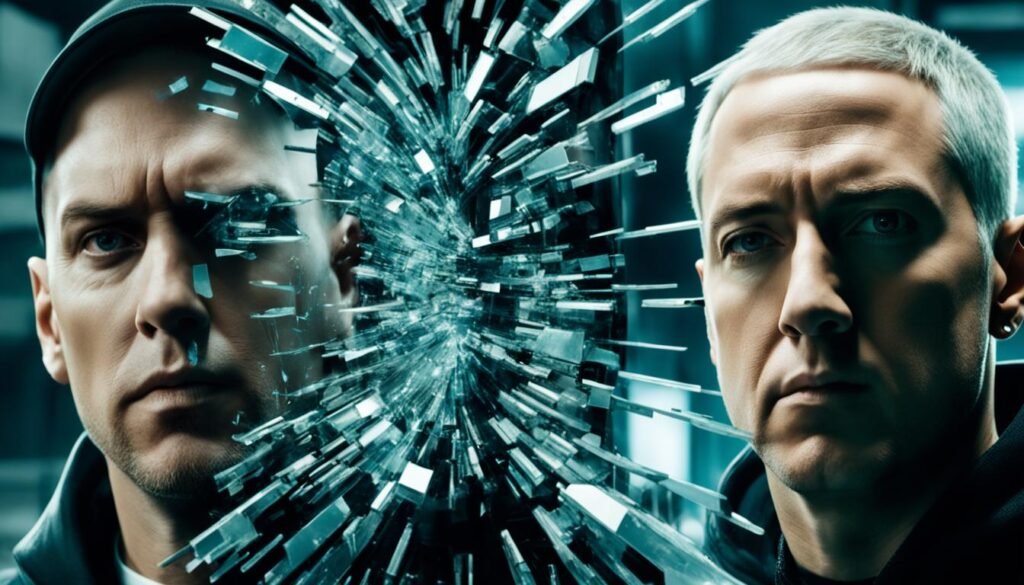Was Eminem Cloned? Sifting Through the Conspiracy

You’ve heard the whispers, the wild internet murmurings that ask, “was Eminem cloned?” It’s the sort of eminem cloning conspiracy that sounds like something straight out of a science fiction novel. Once just a murmured question, it’s now echoed across cyberspace, turning into a full-blown eminem identity mystery. Did one of the world’s greatest rappers really have an android twin step into his shoes?
From his controversial lyrics that slice through societal norms to the brazen honesty of his music, Eminem has always been a figure of intrigue. But the notion that there’s a carbon copy of Marshall Mathers out there has puzzled even his most dedicated fans. Could age and the wear and tear of a hard-lived life account for the changes fans have noticed, or is there more to the story?
Unveiling the Eminem Cloning Conspiracy
As you dive deeper into the turbulent waters of modern celebrity myths, you’ll find the narrative of the Eminem cloning conspiracy. It’s a tale that has seen the rapper’s very identity questioned, with whispers of Eminem lookalike rumors and talk of an Eminem body double leading the charge. The intrigue began with subtle changes that didn’t quite align with the star’s known persona. But what really seeded the idea of a doppelgänger in the minds of many?
The Origin of the Cloning Rumors
The seed was planted when La Guía Del Varón cast out the shocking claim—an android clone had replaced Eminem after a fatal accident in 2006. This sensationalized narrative pointed to a noticeable change in Eminem’s voice, one of the most distinctive in the rap game. It wasn’t the gradual evolution of sound that you might expect with maturation and experience; it was abrupt, a clear demarcation that lined up all too conveniently with the alleged accident, breathing life into the eminem clone controversy.
Public Reaction to the Drastic Transformation
The public, ever the scrutineer of celebrity metamorphoses, took to social media and forums, dissecting alterations in Eminem’s facial structure and jawline. The darker lyrical undertones that followed the alleged incident only added fuel to the fire. These changes were tangible, manifested in doctored images and debates that escalated the conspiracy theory from a whisper to a roar.
Analyzing the Changes in Voice and Style
Yet as you analyze the changes Eminem underwent after 2006—be it in voice, style, or demeanor—it becomes a battleground of opinion. Die-hard fans and skeptics challenge the clone theory, seeing the evolution as nothing out of the ordinary for an artist whose career spans decades. They argue that the darker tone in his music reflects a natural progression rather than evidence of an imposter.
Evidence Suggesting an Eminem Doppelganger Theory
If you’ve been following the saga surrounding one of hip-hop’s most legendary figures, you might be acquainted with the eminem doppelganger theory circulating online. This rabbit hole of speculation suggests that the real Marshall Mathers may have been replaced by an imposter or a clone. But what evidence do proponents of this outlandish theory put forward?
Comparisons of Before and After the Alleged Accident
Devotees of this conjecture draw attention to a set of visual proofs. They invite you to look closely at photos and videos of Eminem before and after 2006—the year he supposedly succumbed to a car accident and was replaced. These side-by-side comparisons often highlight what believers assert is a ‘noticeable’ transformation in Eminem’s facial features, particularly focusing on his jawline.

Picking Apart Eminem’s Physical Alterations
It’s not just about the jawline, though. Enthusiasts of the clone theory also point to the shift in the look of Eminem’s eyes and changes in his posture as proof that the person we see today is not the same ‘Slim Shady’ of the early 2000s. Is eminem a clone, or are these changes the natural result of aging and life’s wear and tear? The doppelganger theory floats on through forums and social media, leaving fans to ponder a truly bizarre possibility in the annals of celebrity lore.
The Rise of the Eminem Clone Theory
Imagine catching a live broadcast, only to see one of the biggest names in hip-hop, Eminem, seemingly ‘glitching’ on-screen. Instantly, social media erupts with fans dissecting the footage, some declaring it was a malfunction—not of the equipment, but of Eminem himself. Yes, you heard that right—people started claiming the real Slim Shady was indeed not real anymore but cloned. The eminem clone theory has surged from a murmur to a full-blown internet frenzy.
The inflection point for this bizarre alternative belief was when B.o.B, another respected artist, took to Twitter. His cryptic tweets about celebrity cloning didn’t just throw gasoline on the already blazing fire; they constructed a whole new narrative. It was as if his comments handed a megaphone to the whispering corners of the internet, amplifying the eminem clone theory into mainstream conversations. Whether you’ve laughed it off or paused in thought, you can’t deny the impact it’s had on online discourse about celebrity culture.
Yet, how do you, as a fan, navigate through such a tangled web of speculation and surrealism? The theory continues to resonate through chatrooms and forums, leaving a trail of memes, gifs, and impassioned debates. Despite lacking scientific proof or an admission from Marshall Mathers himself, the clone theory lingers—a testament to the intriguing power of digital folklore that captivates so many of you.
Analyzing the Shift in Eminem’s Lyrics and Persona
Have you noticed a change in Eminem’s music and style post-2006? It’s not just your imagination. Observers like yourself have pointed out a distinct shift towards darker themes and a more intense hip-hop vibe. This change has sparked endless discussions, with some fans even suggesting it couldn’t be just a natural progression—an eminem clone theory that postulates his very identity might have been tampered with.

This deeper, more aggressive direction, especially evident in albums like ‘Relapse’ and ‘Recovery’, has become the crux of the eminem identity mystery. It’s intriguing to consider how the man who once rapped about cleaning out his closet could transition to a figure so intensely shadowed by his own inner demons.
The Alleged Darker Turn in Musical Direction
You’ve witnessed it—the stark contrast in Eminem’s post-2006 output. Perhaps it’s a reflection of personal evolution, or maybe, as some believe, it’s evidence of something—or someone—new behind the music. This theory, grounded in the eminem clone theory, suggests that an imposter could be masquerading as the real Slim Shady.
Did a Clone Alter Eminem’s Artistic Vision?
The question isn’t just about the music. It’s about the man. Could the dramatic shift in lyrical tone and presentation be the work of a clone? There are those who say yes, a replacement that’s veered away from Eminem’s original vision, plunging into a realm unchartered by the artist we thought we knew. As you mull over his more recent lyrics, it’s hard not to wonder about the mysteries lurking behind the persona of Eminem.
Examining the ‘Glitch’ in Eminem’s Live Appearances
Have you ever seen something so baffling that it made you question reality? That’s exactly what happened when fans across the globe witnessed Eminem’s unusual behavior during a seemingly ordinary ESPN interview. The incident sent the eminem clone controversy into overdrive as armchair analysts strove to dissect every frame; the eminem identity mystery deepened, leading some to believe that the real Slim Shady may not have been the man on their screens.
The Infamous ESPN Footage Breakdown
It was a moment that left viewers scratching their heads — Eminem, the rap icon known for his sharp wit and presence, appeared disjointed and out of character. As the video circulated online, detective work began. Fans zoomed in, played back, and debated every detail, searching for clues that could explain Eminem’s glitchy demeanor. Was this a technical mishap or something more sinister?
B.o.B’s Cryptic Tweets Fueling Cloning Speculation
The plot thickened when rapper B.o.B joined the conversation with cryptic tweets alluding to the existence of celebrity clones. His thoughts on human cloning resonated with those already suspicious of the industry’s underbelly, adding fuel to the conspiracy fire. B.o.B’s words offered validation for believers and provided yet another layer to the consuming intrigue behind the eminem identity mystery that fans couldn’t ignore.
Pop Culture’s Influence on the Eminem Clone Controversy
Imagine flipping through the channels or scrolling down your social feed and stumbling upon a music video that turns your music world upside down. That’s the kind of impact Tom Macdonald’s provocative ‘Cloned Rappers’ made, pulling you further into the spiraling tunnels of the Eminem clone controversy. When pop culture elements like music videos and lyrics from artists such as Macdonald echo the sentiments of a conspiracy, they inevitably fan the flames of discussion among fans and skeptics alike.
Tom Macdonald’s ‘Cloned Rappers’ Intensifies Debate
It’s not just chatter; it’s borderline hysteria once someone drops a tune like ‘Cloned Rappers’. Tom Macdonald’s haunting depiction of an industry where the biggest names, including Eminem, are subject to cloning shenanigans by shady elites, plants seeds of doubt. This music video, with its eye-catching visuals and **eminem body double** insinuations, doesn’t just entertain—it provokes. It makes you question, ponder, and perhaps even believe. This isn’t just a simple rap song; it’s a cultural artifact that shapes the conversation around the eminem clone controversy.
Musical Lyrics and Videos as Conspiracy Catalysts
Lyrical content and visually stimulating music videos have a storied history of influencing public perception and feeding conspiracy theories. When you encounter expressions floating the idea of a clone among us, replacing the original Marshall Mathers, it challenges your comfort zone. Pop culture has this inherent power to impact what you think and what you’re willing to entertain as possible, even in the realm of extreme claims like the existence of an Eminem double.
So, next time you hit play on a song or dive into a music video that claims to reveal the truth behind one of the most controversial figures in rap, ask yourself: are you merely consuming art, or are you part of a phenomenon that blurs the lines between reality and fiction? As you reflect on how the world around us shapes the eminem clone controversy, only one thing’s for certain—it’s a narrative that’s too gripping to ignore.
Conclusion
The Eminem clone theory weaves through the fabric of modern myth-making with a tenacity that is as intriguing as it is perplexing. Claims of striking physical transformations and noticeable shifts in the artist’s musical style have not only sparked curiosity but have lodged the notion of an Eminem identity mystery firmly into the annals of pop culture conspiracies. You’ve seen the evidence presented, from voice changes to jawline alterations, from glitchy interviews to hip-hop’s own lyrical contributions to the saga. Each element adds another layer to the lore, inviting more speculation.
Yet, skepticism remains high among those who lean on rational explanations. Aging, personal evolution, and the pressures of fame can sculpt a person’s presentation and persona over time, leading to natural variations that are far less sensational than cloning. Still, in an era where digital culture is king, the extraordinary tale of Eminem’s doppelgänger refuses to fade away. It thrives on the fuel of viral moments and social media debates, bolstering a narrative fit for a science fiction plot.
As you parse through the nuances of this enduring story, it invites you to ponder the broader implications. The celebrity status, often brightly lit and scrutinized, becomes a canvas for society’s deeper narratives—reflecting our collective intrigue with the unknown and perhaps, our unease with the very nature of identity in the digital age. Whether you subscribe to the clone theory or firmly refute it, one thing is certain: the conversation surrounding Eminem’s identity serves as a compelling case study in how myth can take root in the modern psyche.
FAQ
Was Eminem Cloned?
There is no concrete evidence to support the claim that Eminem was cloned. The rumors started when fans noticed changes in his appearance and musical style, leading to wild speculations. While intriguing as a conspiracy theory, it is widely regarded as false by experts and rational observers.
What Triggered the Eminem Cloning Conspiracy?
The Eminem cloning conspiracy began when some fans perceived changes in Eminem’s voice and a Spanish website, La Guía Del Varón, referred to him as an ‘android clone,’ claiming that the real Eminem died in 2006. This, combined with noticeable physical changes, ignited the conspiracy theory.
How Did the Public React to Eminem’s Transformation?
The public reaction to Eminem’s transformation has been a mix of skepticism and conspiracy theorizing. Some fans simply attribute these changes to the natural aging process and shifts in creative direction, while others speculate more extreme theories involving clones and doppelgängers.
Has Eminem’s Voice and Style Really Changed?
Yes, Eminem’s voice and musical style have evolved over the years. Changes in voice can be due to aging, lifestyle, or artistic choice, while shifts in musical style are common in an artist’s development. However, these natural progressions are sometimes interpreted by conspiracy theorists as proof of cloning.
Are There Visual Comparisons Supporting the Eminem Doppelgänger Theory?
Conspiracy theorists often point to visual comparisons of Eminem before and after the alleged 2006 accident to support their claims. These comparisons typically focus on changes in his jawline or facial structure, but no reliable evidence has substantiated the doppelgänger theory.
What Physical Alterations in Eminem Have Been Picked Apart by Theorists?
Theorists scrutinize Eminem’s facial features, such as the shape of his jawline and the look in his eyes. They argue that these alterations are too drastic to be natural, suggesting the work of a clone or body double, despite such changes often being explicable by other factors like aging or dental work.
What Incidents Have Caused the Eminem Clone Theory to Gain Attention?
The Eminem clone theory gained attention after footage of Eminem ‘glitching’ during a live ESPN broadcast went viral, prompting some to theorize it was evidence of a clone malfunctioning. Rapper B.o.B’s tweets about human cloning also gave some credence to the theory among conspiracy enthusiasts.
How Have Eminem’s Lyrics and Persona Contributed to the Cloning Speculation?
After 2006, Eminem’s lyrics and persona underwent changes, adopting a darker and more introspective tone, diverging from his earlier style. This shift became a focal point for clone theorists, who argue that such a change in artistic vision might be the result of a clone’s influence.
What Was the Impact of Tom Macdonald’s ‘Cloned Rappers’ on the Debate?
Tom Macdonald’s ‘Cloned Rappers’ had a significant impact on the Eminem clone controversy. The song’s lyrics and video fueled conspiracy theories by suggesting that influential rappers, including Eminem, had been cloned. Its popularity in pop culture helped sustain the cloning narrative’s presence in discussions.
How Have Music Videos and Lyrics Served as a Catalyst for Conspiracy Theories?
Music videos and lyrics that allude to clones or depict them, such as those in ‘Cloned Rappers,’ act as a catalyst for conspiracy theories by visually and thematically reinforcing the ideas that fans and conspiracy theorists already have, giving the impression of “evidence” for their beliefs.




Leave a Comment